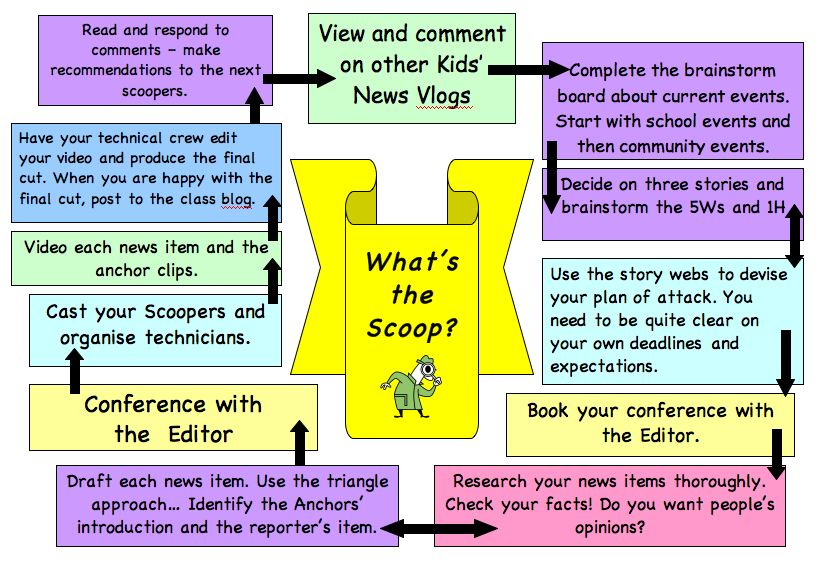Creating News Shows in the Primary School Context
| Work in progress, expect frequent changes. Help and feedback is welcome. See discussion page. |
The intention of this page is for primary school teachers to share and reflect upon their successful (and not-so-successful) processes.
Contents
Why should you give News Shows a go?

News Shows are an exciting way for children to learn many skills. These include but are not limited to:
- Oral Language
- Written Language
- Story Boarding
- Awareness of Current Affairs
- Reading Expressively
- Photography
- Videography
- Film Editing
- Sound Editing
- Forming an opinion
- Working collaboratively
- Giving and receiving feedback
- Contributing to the school and local community
Equipment
Television News
To begin with your news show can be created using minimal equipment. My class has created effective programmes using a webcam and Windows movie maker.
We have then migrated to digital cameras (using the video function), iMovie, Easi-speak microphones.
Through creating collaborative networks we are now looking at using iPads (for teleprompting using the Prompterous app) and regular microphones.
On the odd occasion we have used green screening.
Processes
As this is a part of my Minimally Invasive Education research, my children have created their own processes. Usually they work in groups of around 3-5.
- Oral discusion/brainstorm on which kind of story they will report on (national, world, local or personal event)
- Scripting story on portable whiteboards (this may change to iPad)
- Discussing and deciding on where filming will take place (indoors, outdoors, effective background)
- Negotiating who will film, present, prompt and direct
- Practice
- Film
- Edit (add titles etc iMovie has a very good News Template)
- Add creative commons music if necc (or time permitting)
- Upload to class blog
- Observe News show on our collaborating class's blog
- Give and Receive feedback
- Start process again taking on previous feedback
Here is a visual example of the process from St Clair Primary School classroom:
- An example of the news showfrom St Clair Primary School
Here is an example of a news show scripted, presented, filmed and edited in 60 minutes as a part of our after school news crew club. There are many aspects that the children reflected on and I am sure we will see improvements on content, presentation style, and camera work, week by week. After School New Crew - Thursdays 3-4 pm
Tips from an expert
We were very fortunate to have an experienced TV News Reporter watch our shows and give us some valuable feedback. He suggested that:
- News Presenters need to impart ENERGY
- Presenters have to engage with the audience (he said to imagine you are talking to your very best friend)
When we are doing our PTC (news lingo for Piece To Camera) to remember:
NCR
- Be
- Natural
- Confident
- Relaxed
SOUND
- Sound has been a major issue for us considering we have been using webcam (photobooth) and the video function on standard digital cameras.
- We have recently rectified this with a USB microphone. I made the unfortunate mistake of purchasing an analogue mic (the one with a head-phone kind of plug) and had no joy. There are ways around this but it requires buying additional gadgets. I then plugged in a USB mic (from our Wii rockband) and it worked magnificently!
- For our outdoor work we have started using easi-speak mics. This requires muting the sound on the visuals and overlaying the sound from the easi-speaks. It is really important to use a clapper board for this (we just whack a small whiteboard with a random object) but it is great for sound synching).
- Check out our latest show with this new and improved sound...
- Check out the sound quality from Australia too
Collaborate - a step further
- We have started to take our collaboration a step forward. The children from BPS Geelong (Aus) and BMPS Otara (NZ) have been providing each other feedback through the class blogs. We are also both giving and recieving feedback with St Clair School (Dunedin) NZ. Now we are sending each other clips that we include in the shows to look like a 'live cross over'. This teaches the kids about continuity and shows them how editing can make things appear how they may not actually be.
Here is an example of BMPS being included in the BPS show
Here is an example of BPS being included in the BMPS show
My children have already picked up how this works. You will notice William the Weather Man has started conversing with the people in the previous scene here
Hopefully they will use this technique in the future between their Aus - NZ pieces.
Like this
And another collaborative piece between BMPS and BPS here
Examples of the results
Archive of BMPS After-School News Crew
What's New in the MLU with behind the scenes coverage
What's New in the MLU 29 April 2011
